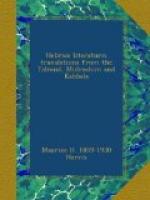In the second stage of its persecution the censor figures. His Philistine pen passed ruthlessly over everything that seemed to hint at criticism of the Church; but not content with expunging the heretical and the inferentially heretical, the censor at times went even so far as to erase sentiments particularly lofty, in order that the Talmud should not have the credit of expounding noble doctrine, nor the Jew the advantage of studying it.
But the latest stage of its persecution belongs to more modern days, when inquisitions were out of date and monkish claws were cut. The traducer would spitefully engage the services of some renegade Jew, to gather from the Talmud all portions and passages that might seem grotesque and ridiculous, so that the world might form an unfavorable impression of the Talmud and of the people who treasure it. This has been done with so much success that up till very recently the Gentile world, including the Christian clergy, knew of the Talmud only through these unfortunate perversions and caricatures. Imagine the citation of a chapter from Leviticus and one from Chronicles, of some vindictive passages in the Psalms, of a few skeptical bits in Ecclesiastes and Job, and one or two of the barbaric stories in Judges, to be offered to the world as a fair picture of the Bible, and you will understand the sort of treatment the Talmud has received from the world at large and the kind of estimate it has been given opportunity to form.
What is the value of the Talmud for the Jew? Certainly its greatest value was rendered in the Middle Ages, when literature was scant and copies of the few books in existence were rarer. When the Jew was shut out of the world’s pleasure and the world’s culture and barred up in Ghetto slums, then it was that the Talmud became his recreation and his consolation, feeding his mind and his faith. In this way it not only became in the Middle Ages a picture of the Jew, but largely formed his character. It made him a keen dialectician, tempered with a thoughtful and poetic touch. It fostered his patience and his humor and kept vivid his ideals. It linked him with the Orient, while living in the Occident and made him a bridge between the old and the new.
To the world at large it has great value archaeologically. Here are preserved ancient laws, glint lights on past history, forgotten forms in the classic tongues, and pictures of old civilization. No one criticism can cover the whole work. It is so many-sided. It includes so many different standards of worth and value. If we take it as a whole, it is good, it is bad and indifferent; it is trash and it is treasure; it is dust and it is diamonds; it is potsherd and it is pearls; and in the hands of impartial scholars, it is one of the great monuments of mental achievement, one of the world’s wonders.
Maurice H. Harris




